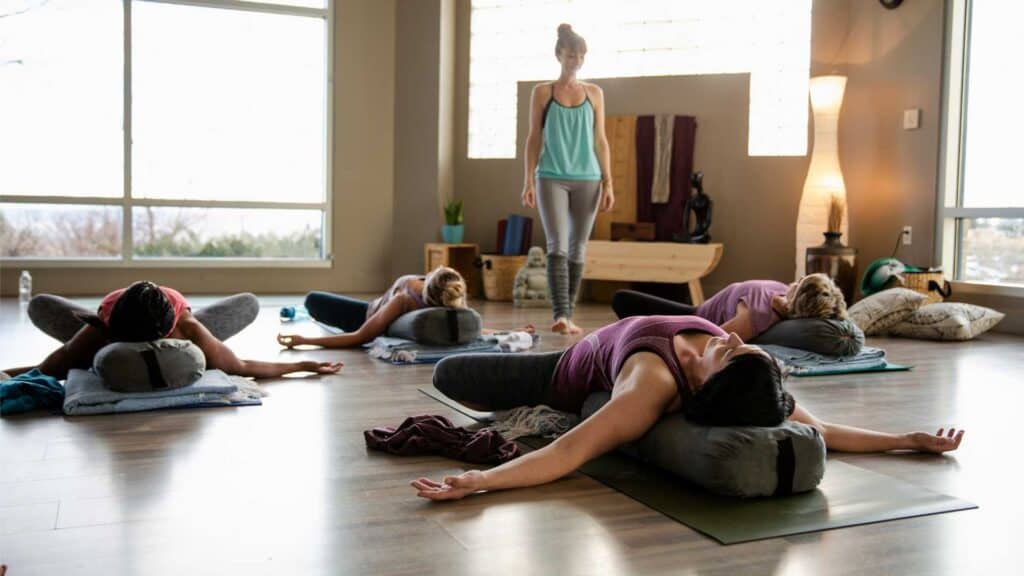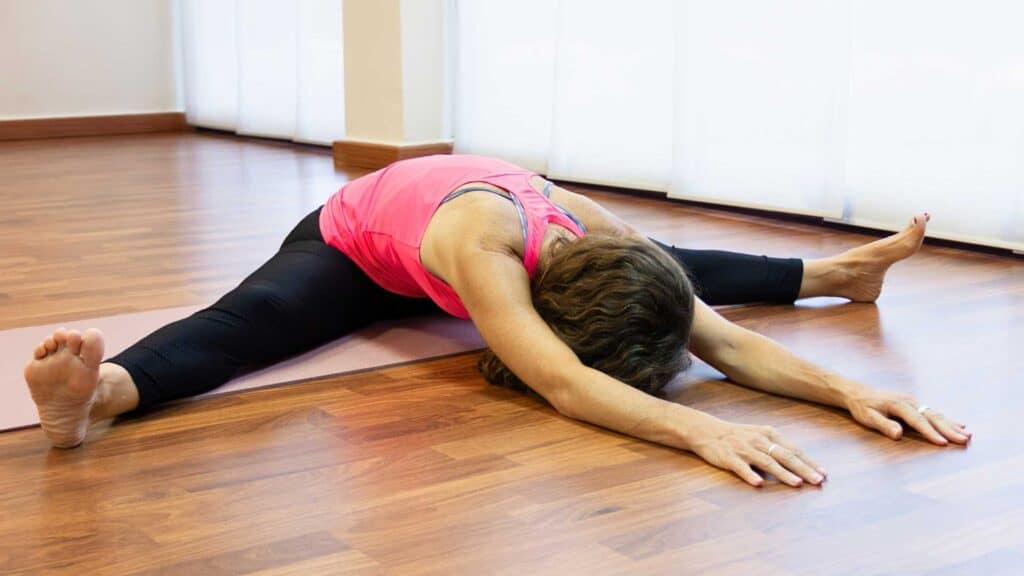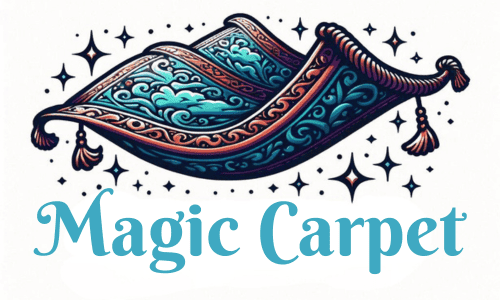Exploring the serene landscapes of restorative and yin yoga can be a transformative journey into relaxation and self-discovery.
Restorative yoga, with its emphasis on deep relaxation, allows you to experience total release as each posture decompresses the mind and body, encouraging a state of passive healing.
On the bolstered sanctuary of your mat, you’ll find a practice that uses props extensively to support your limbs in a way that eliminates strain, nurturing a profound sense of peace and restoration.

On the other hand, yin yoga invites a different kind of introspection. The quiet endurance of longer-held poses targets connective tissues, such as ligaments and fascia.
Here, the gentle tension is a physical experience and an internal journey.
As you maintain each posture, yin yoga teaches resilience and offers a space to explore the depths of your inner landscape.
Key Takeaways
- Restorative yoga focuses on relaxation and restoration, using props to eliminate strain.
- Yin yoga emphasizes gentle stretching and resilience, targeting connective tissues with longer-held poses.
- Both styles offer unique benefits, encouraging relaxation, healing, and self-awareness.
Restorative Yoga Practice

Restorative yoga is a gentle and therapeutic form of yoga that encourages deep relaxation for your body and mind. It’s about slowing down and opening the body through passive stretching.
Key Principles of Restorative Yoga
Restorative yoga focuses on reducing stress and increasing relaxation. This is achieved through several key principles:
- Minimal Effort: The poses are designed to eliminate strain and effort by using various props to support your body.
- Prolonged Holds: Each pose is typically held for 5 to 20 minutes, allowing your body to surrender to the practice completely.
- Relaxed Muscles: Unlike other forms of yoga, you allow your muscles to relax rather than actively engage them.
Benefits of Restorative Yoga
The benefits of this form of Yoga extend beyond simple flexibility:
- Stress Reduction: It effectively reduces stress by shifting the balance from your sympathetic nervous system (fight or flight response) to your parasympathetic nervous system (rest and digest).
- Improved Sleep: Regular practice can promote better sleep by relaxing the mind and body.
Common Restorative Yoga Poses
Some common poses in Restorative Yoga include:
- Supported Child’s Pose (Balasana): Use a bolster or folded blankets to support your torso.
- Legs-Up-The-Wall Pose (Viparita Karani): Elevate your legs using a wall for support, possibly with a bolster underneath your lower back.
- Supported Bound Angle (Supta Baddha Konasana): Support your knees with cushions or bolsters to prevent strain injuries.
Yin Yoga Practice

Yin Yoga offers a meditative approach focused on stretching your deep connective tissues. It’s marked by its slow-paced style, giving you time to explore the depth of each posture.
Core Elements of Yin Yoga
In Yin Yoga, the key elements include holding postures for longer durations and applying moderate stress to the body’s connective tissues, such as the ligaments, tendons, and fascia.
Here, your objective isn’t to exert muscular effort but to relax into the poses, allowing gravity to deepen the stretch.
Yin Yoga aims to improve circulation in the joints and increase flexibility.
- Posture: Emphasized postures often involve seated and supine positions.
- Time: Poses are held typically for three to five minutes.
- Stillness: A quiet and meditative environment is encouraged to assist in turning inward.
Yin Yoga’s Impact on the Body
Yin Yoga’s gentle tension on connective tissues helps to improve flexibility and promote the healing of fascia, which impacts your overall mobility.
By targeting the muscles and deep connective tissues, you influence the flow of energy in the meridians, or energy channels, that run through the connective tissue.
The practice encourages a balance between yang (more dynamic and muscular forms of yoga) and yin (calm and passive aspects), which can lead to a balanced energy flow and a deeper sense of well-being.
- Connective Tissue & Fascia: Stressed safely to encourage strengthening and lengthening.
- Meridian Theory: Poses are thought to improve energy flow along these pathways.
Typical Yin Yoga Sequences
A typical Yin Yoga sequence may start with grounding postures like the Butterfly pose, move into poses such as Sphinx or Seal, and gradually progress into deeper stretches such as the Dragon pose.
Sequences often conclude with a long-held Savasana, which allows deep relaxation to culminate the practice.
- Begin with gentle grounding poses to relax and prepare the body.
- Progress through a series of Yin Yoga poses, focusing on one area of the body before moving to the next.
- End with a deeply restorative pose, allowing the body to assimilate the benefits.
Comparing Styles and Approaches

When you explore the difference between the two forms of yoga, you will notice key characteristics in their styles and approaches.
Yin Yoga encourages you to hold postures for extended periods, usually several minutes. It aims to apply moderate stress to the connective tissues—the joints and fascia—to enhance circulation and flexibility. Its objective is not just physical; it’s also meditative, urging you to reach a deeper level of inner stillness.
On the other hand, Restorative Yoga deeply supports your body in each pose, typically using props like bolsters, blocks, and blankets.
This approach emphasizes minimal effort on your part, allowing for complete relaxation and recovery.
Here, the focus shifts away from deep tissue stimulation and towards a tranquil state where the body can naturally heal and renew itself.
| Style | Approach | Focus |
|---|---|---|
| Yin Yoga | Postures held for longer periods; moderate stress | Connective tissue; meditative |
| Restorative Yoga | Fully supported poses; no stress | Deep relaxation; recovery |
How Yin and Restorative Yoga Complement Each Other

While distinct in their approaches, restorative and Yin Yoga provide a well-rounded practice that offers deep relaxation and stimulation for the body’s tissues. Integrating both can enhance your yoga journey.
Yin yoga encourages you to reach a point of tension and maintain it, helping to stimulate the deeper connective tissues such as ligaments and fascia.
This is achieved through passive holds that last several minutes, urging a sense of resilience in the posture. The idea is to apply moderate stress to these tissues, which can be revitalizing when done with care.
Conversely, restorative yoga invites you to use props extensively to support your body in poses, fostering an environment where muscular tension can dissipate.
This yoga practice emphasizes complete relaxation, allowing you to delve into a state of rest and recuperation.
When yin yoga’s stimulating nature pairs with the nurturing essence of restorative yoga, a synergistic effect occurs.
Through its endurance-based poses, yin can improve flexibility and encourage a meditative state, while restorative yoga offers deep relaxation and helps recover from fatigue and stress.
Together, they provide a comprehensive regime that nurtures both active and passive elements of your body’s needs.
Incorporating both styles into your regular routine allows you to explore and enjoy the complementary benefits of both active stimulation and passive relaxation. This can lead to a more balanced yoga practice and enhanced well-being.
The Role of Props in Yin and Restorative Yoga

In Yin practice and Restorative Yoga, props play an essential role in enhancing the experience. They serve various purposes but share a common goal: to aid in comfort and support the body’s journey into relaxation and deeper stretches.
Yin Use of Props
Yin Yoga typically employs minimal props. Your body’s weight and gravity are often enough to deepen into a pose.
However, props such as bolsters, blocks, and straps are sometimes introduced to maintain alignment or offer depth in a posture.
You might use a block to support your hands in a forward fold or a bolster to elevate your hips in a pigeon pose.
Props are used strategically to apply gentle stress to connective tissues, increasing flexibility and circulation.
Poses are held longer, around 3-5 minutes, necessitating comfortable support.
Restorative Use of Props
In contrast, Restorative Yoga fully embraces the use of props. A typical session requires abundant props to support the body completely.
Imagine resting in a pose where bolsters, blankets, and cushions cradle every part of your body. This environment allows you to release all muscle tension.
Since the focus is on relaxation rather than stretching, the props are arranged so you can stay longer in a pose, usually up to 10 minutes, with little to no sensation of stretch or effort.
| Yoga Style | Prop Use | Common Props | Purpose |
|---|---|---|---|
| Yin Yoga | Minimal to moderate | Blocks, Straps, Bolsters | To maintain alignment and add depth to poses |
| Restorative Yoga | Extensive | Bolsters, Blankets, Sandbags, Straps, Blocks | To completely support the body for relaxation |
Yoga Class Structures
What to Expect in a Restorative Yoga Class
In a class, you’ll be welcomed into a calm environment for deep relaxation.
You should bring:
- Comfortable clothes that allow for unrestricted movement,
- An open mind ready for tranquil experiences.
Class flow typically involves:
- A brief introduction and settling in,
- Gentle transitions between a small number of poses,
- Each pose is held for a significant duration, often up to 10 minutes,
- Extensive props like blankets, bolsters, and blocks to support your body in a passive state,
- Guidance aimed at facilitating complete relaxation and stress relief.
Your takeaway: An experience of profound calm and unwinding of the body’s tension.
What to Expect in a Yin Yoga Class
Your experience with a yin yoga teacher in a class will contrast through their focus on gentle tension and stretching of connective tissues.
Essentials for this class include:
- Clothing that keeps you warm as your body cools down during long holds,
- Patience as you maintain poses for extended periods.
During the class, you can expect:
- An introduction that may explain the purpose of yin yoga,
- To transition into poses that are more passive but held for 3-5 minutes, creating mild, healthful stress on connective tissues,
- Moments where you wouldn’t use props to allow gravity to deepen the stretch,
- Instructor-led mindfulness or meditative components.
Takeaway for you: A practice that increases your flexibility and encourages a sense of inner stillness.
Difference Between Yin Yoga and Restorative Yoga Philosophies and Origins
When you explore the Yin and Restorative styles of yoga, you experience two practices rich in tradition and philosophy. Each has its own unique historical backdrop that has shaped the development and practice of these calming yoga styles.
Historical Background of Yin Yoga
The Yin style of Yoga originated from the ancient Chinese Taoist concept of balancing opposing forces—the yin and the yang.
Paul Grilley developed this practice in the late 20th century, influenced by his martial arts and anatomy studies. Grilley and his student Sarah Powers helped formalize it into the quiet, meditative yoga practice you know today.
It integrates the principles of traditional Chinese medicine with Taoist yoga, emphasizing the stimulation of the body’s meridian lines and fostering a balance between relaxation and gentle stress on the connective tissues.
Historical Background of Restorative Yoga
Restorative Yoga stems from the teachings of B.K.S. Iyengar, a prominent figure in modern yoga. He had a philosophy centered around healing and relaxation. This practice leverages props such as bolsters, blankets, and straps to minimize strain and support the body completely.
One of Iyengar’s students, Judith Hanson Lasater, played a significant role in popularizing Restorative Yoga in the West. She emphasized the use of props to facilitate complete relaxation in each pose. This is key to the practice and sets it apart from other forms of yoga.
Further Reading
You may wish to read our article describing the differences between the Vinyasa and Ashtanga forms of yoga.
